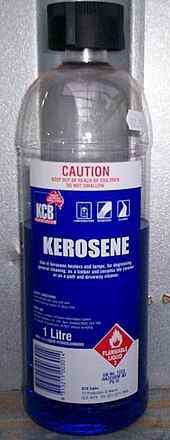
Kerosene, or paraffin, is a combustible hydrocarbon liquid which is derived from petroleum. It is widely used as a fuel in aviation as well as households. Its name derives from κηρός (kērós) meaning "wax", and was registered as a trademark by Nova Scotia geologist and inventor Abraham Gesner in 1854 before evolving into a generic trademark. It is sometimes spelled kerosine in scientific and industrial usage.[1]
Kerosene is widely used to power jet engines of aircraft (jet fuel), as well as some rocket engines in a highly refined form called RP-1. It is also commonly used as a cooking and lighting fuel, and for fire toys such as poi. In parts of Asia, kerosene is sometimes used as fuel for small outboard motors or even motorcycles.[2] World total kerosene consumption for all purposes is equivalent to about 5,500,000 barrels per day as of July 2023.[3]
The term "kerosene" is common in much of Argentina, Australia, Canada, India, New Zealand, Nigeria, and the United States,[4][5] while the term paraffin (or a closely related variant) is used in Chile, East Africa, South Africa, Norway, and the United Kingdom.[6] The term "lamp oil", or the equivalent in the local languages, is common in the majority of Asia and the Southeastern United States, although in Appalachia, it is also commonly referred to as "coal oil".[7]
Confusingly, the name "paraffin" is also used to refer to a number of distinct petroleum byproducts other than kerosene. For instance, liquid paraffin (called mineral oil in the US) is a more viscous and highly refined product which is used as a laxative. Paraffin wax is a waxy solid extracted from petroleum.
To prevent confusion between kerosene and the much more flammable and volatile gasoline (petrol), some jurisdictions regulate markings or colourings for containers used to store or dispense kerosene. For example, in the United States, Pennsylvania requires that portable containers used at retail service stations for kerosene be colored blue, as opposed to red (for gasoline) or yellow (for diesel).[8][9]
The World Health Organization considers kerosene to be a polluting fuel and recommends that "governments and practitioners immediately stop promoting its household use".[10] Kerosene smoke contains high levels of harmful particulate matter, and household use of kerosene is associated with higher risks of cancer, respiratory infections, asthma, tuberculosis, cataracts, and adverse pregnancy outcomes.[11]
- ^ "Kerosene". Webster's New World College Dictionary.
- ^ "Kerosene Outboard Motors". Retrieved 25 October 2011.
- ^ Kerosene consumption in the World Archived 5 August 2022 at the Wayback Machine. World Data Atlas, Knoema
- ^ "Kerosene". Oxford English Dictionary.
- ^ "Has kerosene become a generic trademark?". genericides.org. 23 March 2020. Archived from the original on 7 February 2021. Retrieved 28 January 2021.
- ^ What is Kerosene – Ingoe Oils Ltd Archived 2 August 2017 at the Wayback Machine. Ingoeoils.co.uk. on 2 June 2015,
- ^ "Lamp oil Definition & Meaning | Dictionary.com". Archived from the original on 9 July 2021. Retrieved 4 July 2021.
- ^ "Pennsylvania Combustible and Flammable Liquids Act". Archived from the original on 7 July 2016. Retrieved 28 April 2014.
- ^ "Fuel Storage Cans - Getting the Color Right". Horizon Distributors - Irrigation & Landscape Supply. Archived from the original on 10 April 2021. Retrieved 20 October 2020.
- ^ World Health Organization (2016). Burning opportunity: clean household energy for health, sustainable development, and wellbeing of women and children. Geneva, Switzerland. p. X. Archived from the original on 24 November 2017.
{{cite book}}: CS1 maint: location missing publisher (link) - ^ World Health Organization (2016). Burning opportunity: clean household energy for health, sustainable development, and wellbeing of women and children. Geneva, Switzerland. p. 49. Archived from the original on 24 November 2017.
{{cite book}}: CS1 maint: location missing publisher (link)